Zoom
Trash

RP-408. Liquid scintillation counting. Liquid scintillation counting is a standard laboratory method in the life-sciences for measuring radiation from beta-emitting radioactive isotopes.
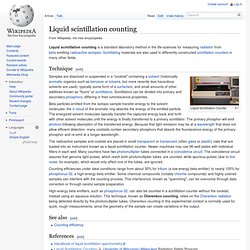
Scintillating materials are also used in differently constructed scintillation counters in many other fields. Technique[edit] Liquid Scintillation Counter Samples are dissolved or suspended in a "cocktail" containing a solvent (historically aromatic organics such as benzene or toluene, but more recently less hazardous solvents are used), typically some form of a surfactant, and small amounts of other additives known as "fluors" or scintillators. Scintillators can be divided into primary and secondary phosphors, differing in their luminescence properties. Cherenkov radiation. Cherenkov radiation, also known as Vavilov-Cherenkov radiation, (also spelled Čerenkov or Cerenkov) is electromagnetic radiation emitted when a charged particle (such as an electron) passes through a dielectric medium at a speed greater than the phase velocity of light in that medium.
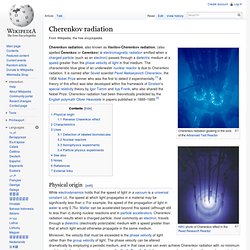
The characteristic blue glow of an underwater nuclear reactor is due to Cherenkov radiation. It is named after Soviet scientist Pavel Alekseyevich Cherenkov, the 1958 Nobel Prize winner who was the first to detect it experimentally.[1] A theory of this effect was later developed within the framework of Einstein's special relativity theory by Igor Tamm and Ilya Frank, who also shared the Nobel Prize. Unters. zur Ortsempf. von Szintillatoren. Radiation Laboratories. Advanced Time-of-Flight (ToF) PET Photon Detectors - Research - Molecular Imaging Instrumentation Laboratory - Stanford Medicine. For the last three decades, a significant amount research has focused on improving the scintillation crystal of the detector to go beyond simple coincidence detection capability to time-of-flight (ToF) capability.
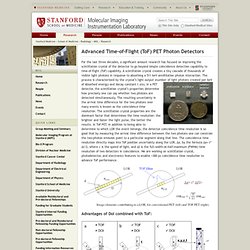
A scintillation crystal creates a tiny cascade of thousands of visible light photons in response to absorbing a 511 keV annihilation photon interaction. The process is characterized by the crystal’s light output (number of light photons created per keV of absorbed energy) and decay constant t (ns). In a PET detector, the scintillation crystal’s properties determine how precisely one can say whether two photons are detected simultaneously. The resulting uncertainty in the arrival time difference for the two photons over many events is known as the coincidence time resolution.
The scintillation crystal properties are the dominant factor that determines the time resolution: the brighter and faster the light pulse, the better the results. Untitled. Www.tpub.com/content/doe/h1013v2/img/h1013v2_70_2. Farnell Deutschland. SiC-Detektoren (200 - 400 nm) - UV-Detektoren ab 200 nm. Photonics. Digital Imaging in Optical Microscopy - Concepts in Digital Imaging - Avalanche Photodiodes. Concepts in Digital Imaging Technology Avalanche Photodiodes An avalanche photodiode is a silicon-based semiconductor containing a pn junction consisting of a positively doped p region and a negatively doped n region sandwiching an area of neutral charge termed the depletion region.

These diodes provide gain by the generation of electron-hole pairs from an energetic electron that creates an "avalanche" of electrons in the substrate. Presented in Figure 1 is an illustration of a typical avalanche photodiode. Photons entering the diode first pass through the silicon dioxide layer and then through the n and p layers before entering the depletion region where they excite free electrons and holes, which then migrate to the cathode and anode, respectively.
Avalanche diodes are very similar in design to the silicon p-i-n diode, however the depletion layer in an avalanche photodiode is relatively thin, resulting in a very steep localized electrical field across the narrow junction. Kenneth R. Avalanche Photodiode for 3D Imaging. Untitled. Entwicklung von Scintillationszählerprototypen.
Polyvinyltoluene scintillators for relative ion dosimetry. Why cannot a solid scintillation counter be used to measure beta activity. Cosmic Ray Tests of a Prototype TOF Counter. Next: Tests of a Up: A Time-of-Flight System for Previous: Trigger Considerations To optimize the performance of TOF counters of the geometry we plan to use in the CDT location we have begun testing prototype counters at Fermilab.
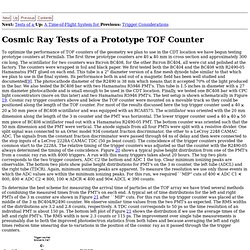
The first three prototype counters are 40 40 mm in cross section and approximately 300 cm long. The scintillator for two counters was Bicron BC408, for the other Bicron BC404, all were cut and polished at the factory. The counters were wrapped in foil and black paper. Plastic Scintillators. Bicron_BC400-416_Scintillators.
Flugzeitmassenspektrometer. Polyvinyl toluene. Polyvinyltoluene (PVT, polyvinyl toluene) is a synthetic polymer.

PVT can be doped with anthracene to produce a plastic scintillator. When subjected to ionizing radiation (both particle radiation and gamma radiation), the amount of visible radiation emitted is proportional to the absorbed dose. PVT can be damaged by radiation with high stopping power, e.g. ion beams. Such radiation breaks the C-H bonds and significantly reduces the luminescence yield.[1] Anthracene. Anthracene is a solid polycyclic aromatic hydrocarbon of formula C14H10, consisting of three fused benzene rings.
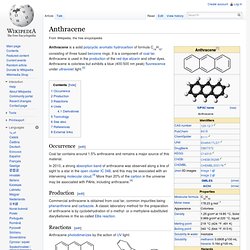
It is a component of coal tar. Anthracene is used in the production of the red dye alizarin and other dyes. Lagerverkauf - Korth Kristalle GmbH. Cäsiumjodid - Korth Kristalle GmbH. Caesiumiodid. Sicherheitsdatenblatt. Calciumfluorid - Korth Kristalle GmbH. Scintillator. Scintillation crystal surrounded by various scintillation detector assemblies.
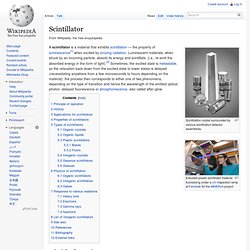
Extruded plastic scintillator material fluorescing under a UV inspection lamp at Fermilab for the MINERνA project Principle of operation[edit] A scintillation detector or scintillation counter is obtained when a scintillator is coupled to an electronic light sensor such as a photomultiplier tube (PMT), photodiode, or silicon photomultiplier. PMT's absorb the light emitted by the scintillator and reemit it in the form of electrons via the photoelectric effect. Szintillationszähler. Szintillator. Scintillation Detectors:Gamma-Ray Spectra. Scintillation Detectors. Kosmische Strahlung.
Neutrinos - Geheimschrift des Kosmos. VO-5-Szintillatoren. X-ray Detectors, Hamamatsu. Scintillation counter. Schematic showing incident particles hitting a scintillating crystal, triggering the release of photons which are then converted into photoelectrons and multiplied in the photomultiplier.
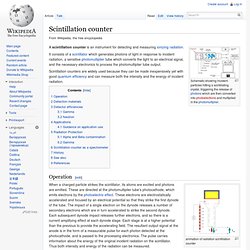
A scintillation counter is an instrument for detecting and measuring ionizing radiation. It consists of a scintillator which generates photons of light in response to incident radiation, a sensitive photomultiplier tube which converts the light to an electrical signal, and the necessary electronics to process the photomultiplier tube output. Scintillation counters are widely used because they can be made inexpensively yet with good quantum efficiency and can measure both the intensity and the energy of incident radiation. Operation[edit] Fast Neutron Induced Nuclear Counter Effect in Hamamatsu Silicon PIN Diodes and APDs. Leuchtstoff. Zinksulfid. ZnS. Phosphor. Example of phosphorescence Aperture grille CRT phosphors A phosphor, most generally, is a substance that exhibits the phenomenon of luminescence.
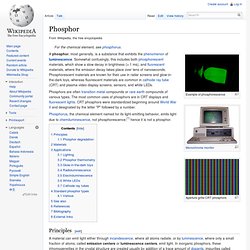
Somewhat confusingly, this includes both phosphorescent materials, which show a slow decay in brightness (> 1 ms), and fluorescent materials, where the emission decay takes place over tens of nanoseconds. Phosphorescent materials are known for their use in radar screens and glow-in-the-dark toys, whereas fluorescent materials are common in cathode ray tube (CRT) and plasma video display screens, sensors, and white LEDs. Phosphors are often transition metal compounds or rare earth compounds of various types. Phosphorus, the chemical element named for its light-emitting behavior, emits light due to chemiluminescence, not phosphorescence;[1] hence it is not a phosphor. Principles[edit] The scintillation process in inorganic materials is due to the electronic band structure found in the crystals. Phosphor degradation[edit] Examples:
Photomultiplier. Schematische Skizze eines Photomultipliers Photomultiplier, Länge ca. 8 cm; rechts das Eintrittsfenster mit Photokathode, in der Mitte die an Isolierkörpern befestigten Dynoden Photomultiplier, Länge ca. 17 cm; links das Eintrittsfenster mit Photokathode, in der Mitte die an Isolierkörpern befestigten Dynoden Blick durch das Eintrittsfenster (mit Photokathode) auf die erste Dynodenstufe Funktionsweise[Bearbeiten] Die Photonen treffen auf die Photokathode und lösen durch den äußeren photoelektrischen Effekt Elektronen aus deren Oberfläche, wie bei einer Photozelle.
Der Verstärkungsfaktor wächst exponentiell mit der Anzahl der Dynoden. Wegen ihrer hohen Empfindlichkeit müssen die meisten Photomultiplier bei Betrieb vor Beleuchtung mit Tageslicht geschützt werden, weil der Einfall von zu vielen Photonen einen zu hohen Strom erzeugt und die Fähigkeit der Beschichtung der Dynoden (z. Einzelphotonennachweis[Bearbeiten] Pulsverhalten[Bearbeiten] Vorpulse: Spätpulse: Nachpulse: Digital Imaging in Optical Microscopy - Concepts in Digital Imaging - Photomultiplier Tubes.
Concepts in Digital Imaging Technology Photomultiplier Tubes A photomultiplier tube, useful for light detection of very weak signals, is a photoemissive device in which the absorption of a photon results in the emission of an electron. These detectors work by amplifying the electrons generated by a photocathode exposed to a photon flux. Photomultipliers acquire light through a glass or quartz window that covers a photosensitive surface, called a photocathode, which then releases electrons that are multiplied by electrodes known as metal channel dynodes. At the end of the dynode chain is an anode or collection electrode.